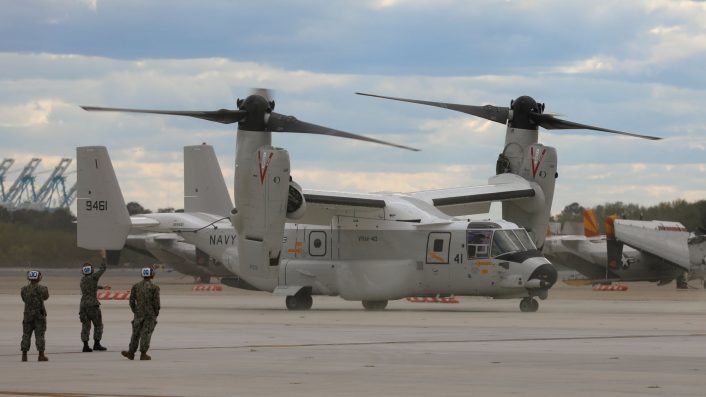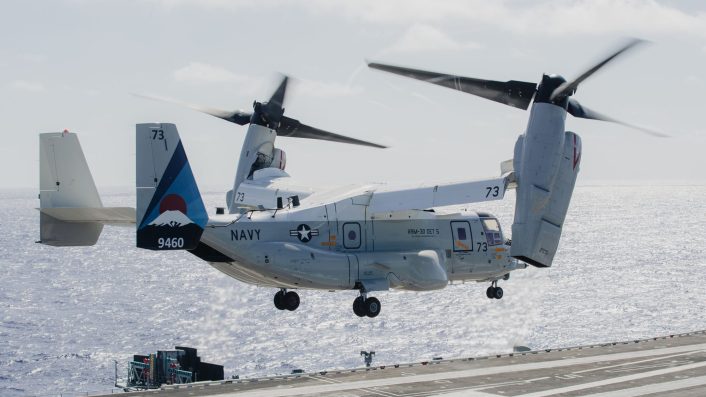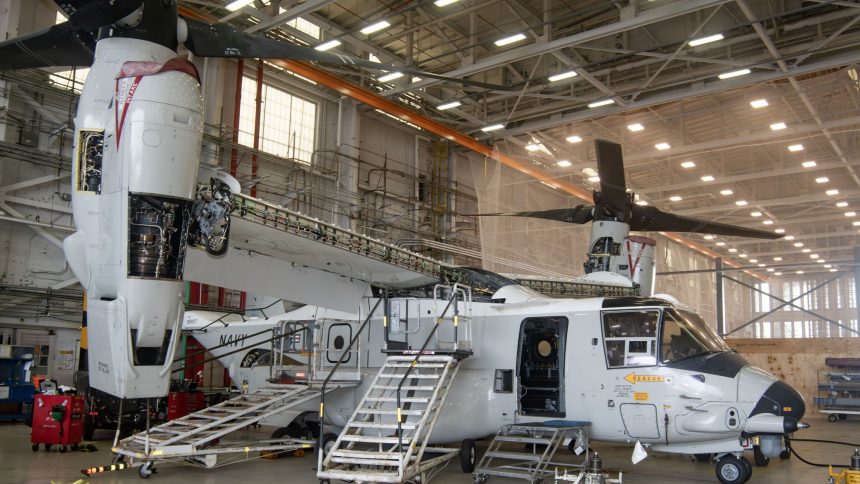With the start of the first Planned Maintenance Interval 1 service to the CMV-22B aircraft, the depot now services all three variants of the V-22 platform, which also include the Marine Corps MV-22B and the Air Force CV-22.
The FRCE (Fleet Readiness Center East) at MCAS (Marine Corps Air Station) Cherry Point, North Carolina, announced the start of the planned maintenance of its first U.S. Navy CMV-22B. Although the depot received the tiltrotor on Aug. 21, 2024, the news was only released on Nov. 12. The facility now maintains all three variants of the Ospreys, including the U.S. Marine Corps’ MV-22B and the U.S. Air Force’s CV-22B.
The CMV-22B is the newest Osprey variant, entering service in Jun. 2020 on the West Coast and Apr. 2024 on the East Coast, and is specifically modified for the Navy’s needs. The Marine Corps MV-22B Osprey has been flying since 2007 after it acquired the initial operational capability, while the Air Force CV-22 variant has been in operational use since 2009.
The current PMI 1 (Planned Maintenance Interval 1) marks the FRCE taking on the “responsibility for the Navy’s East Coast-based CMV-22B fleet.” Along with the detachments at MCAS New River, North Carolina, and at the Air Force’s Hurlburt Field, Florida, the FRCE has so far only serviced the MV-22B and the CV-22 variants.
VRM-50 “Sunhawks” came to Fort Worth for a flyover of the UCF vs. TCU game. VRM-50 is a Fleet Replacement Squadron (FRS) for the CMV-22B Osprey aircraft.
169447 CMV-22B SB 50 VRM-50 pic.twitter.com/zJs47a6OeA
— Sam Combs (@pressxtolive) September 15, 2024
It is interesting to note that the aircraft shown in the photo has the registration #169437, which identifies it as the first operational CMV-22B Osprey delivered to the U.S. Navy on June 22, 2020. This “CODsprey” (as some nicknamed the new aircraft) is assigned to Fleet Logistics Multi-Mission Squadron 30 (VRM-30) “Titans” at Naval Air Station North Island.
The Navy’s CMV-22B Osprey
While the USMC and the U.S. Air Force’s AFSOC (Air Force Special Operations Command) use their Ospreys for largely the same roles of transporting troops to combat zones, the Navy employs the CMV-22B for medium-lift aerial logistics, including the COD (Carrier Onboard Delivery) mission.
A major difference between the Navy’s CMV-22B and the Marine Corps MV-22B, which largely share the same maintenance requirements, is the presence of the fuel tank extensions to the forward portion of the sponsons on both sides of the fuselage. This modification allows the Navy aircraft to attain the much needed extra-range for COD roles and offers increased mission flexibility over the Navy’s legacy C-2A Greyhound, says the Navy.

The image released on DVIDS shows the CMV-22B in the depot’s Hangar 1. The panels under the engine intakes, the side of the nacelles, the wing’s leading edge and wing to body fairings are removed. The aerial refueling probe is also in a retracted position.
Notably, following the Nov. 29, 2023, accident of an Air Force CV-22 off the coast of Japan, which killed eight personnel and triggered a safety stand down of about 400 Osprey aircraft, the Navy had increased the deployment of its remaining C-2A Greyhounds to meet the COD missions.
Maintenance work
FRCE Commanding Officer Capt. Randy J. Berti said the depot’s staff can handle the new workload with their famous record of quality workmanship. “FRC East’s maintenance of all three variants of the V-22 Osprey, for three different branches of the U.S. Armed Forces really highlights the reputation (of) our artisans, engineers and support staff,” Berti said.
FRCE V-22 Branch Head Allen Williamson also said the PMI 1 for the CMV-22B aircraft will closely mirror the PMI 1 evolutions already performed on the MV-22B. The FRCE’s depots at MCAS Cherry Point and MCAS New River have serviced the MV-22B since 2009, while the FRCE detachment at Hurlburt Field, Florida, has serviced the Air Force CV-22 variant.
A US Navy CMV-22B Osprey lands at Naval Air Facility Atsugi in Japan on Nov. 7. It is embarked on forward-deployed aircraft carrier USS George Washington (CVN-73). pic.twitter.com/68RTuPRc2c
— Ryan Chan 陳家翹 (@ryankakiuchan) November 13, 2024
“There are very, very low flight hours on these initial CMV-22 aircraft we’ll be receiving, so they’re essentially in new condition,” Williamson said. “We presume the work scope is going to build in the future, based on the theater they’ll be operating in.”
With the Navy indicating plans to deploy the CMV-22B, a “high-use” aircraft, in “harsh environments” such as ships at sea, and will inform the condition of these airframes and the nature of repairs they would require in future.
An interim measure is for the team to approach the CMV-22B maintenance with “fresh eyes” as if it were a new capability, rather than an extension of the familiar workload with “pre-existing expectations.”
Paint job
The FRCE’s detachment at Cherry Point is also refining an interesting laser projection system, meant to paint unit and service markings on aircraft, to be used on the naval CMV-22B during the PMI 1. The personnel is also getting accustomed to different livery and paint schemes on this variant, which is white in color, as opposed to the standard light gray and dark gray found on the MV-22B and CV-22, respectively.

This is the “biggest difference,” according to Williamson, in the CMV-22B’s depot-level maintenance. The newer variant uses a different type of paint than the standard MV-22B and, as a Navy aircraft, has different markings than the Marine Corps version.
The “high-gloss paint” required different preparation and application methods compared to the standard MV-22B, said Paint and Clean Branch Head Matt Sinsel. “There will be some differences in the masking process, because the paint scheme is a little higher-profile than the standard gray Ospreys,” he added.
The team, however, is not new to this as it does already use “high gloss” paints on the HMX-1’s (Marine Helicopter Squadron 1) MV-22 Ospreys, as well as the unit’s other helicopters. The squadron is responsible for the transportation of the President, Vice-President and other VIPs.
The paint type is also found on the Air Force’s H-1 and the State Department’s H-46 helicopters. “But there will be some differences, and there will be some learning involved,” Sinsel said. The CMV-22B’s unique paint scheme is also “another opportunity” to use the laser projection system the depot introduced in January to streamline the final finish process. While applying an aircraft’s insignia and other markings to the finished base paint, the system guides the precise placement of the markings without having to use paper stencils.









